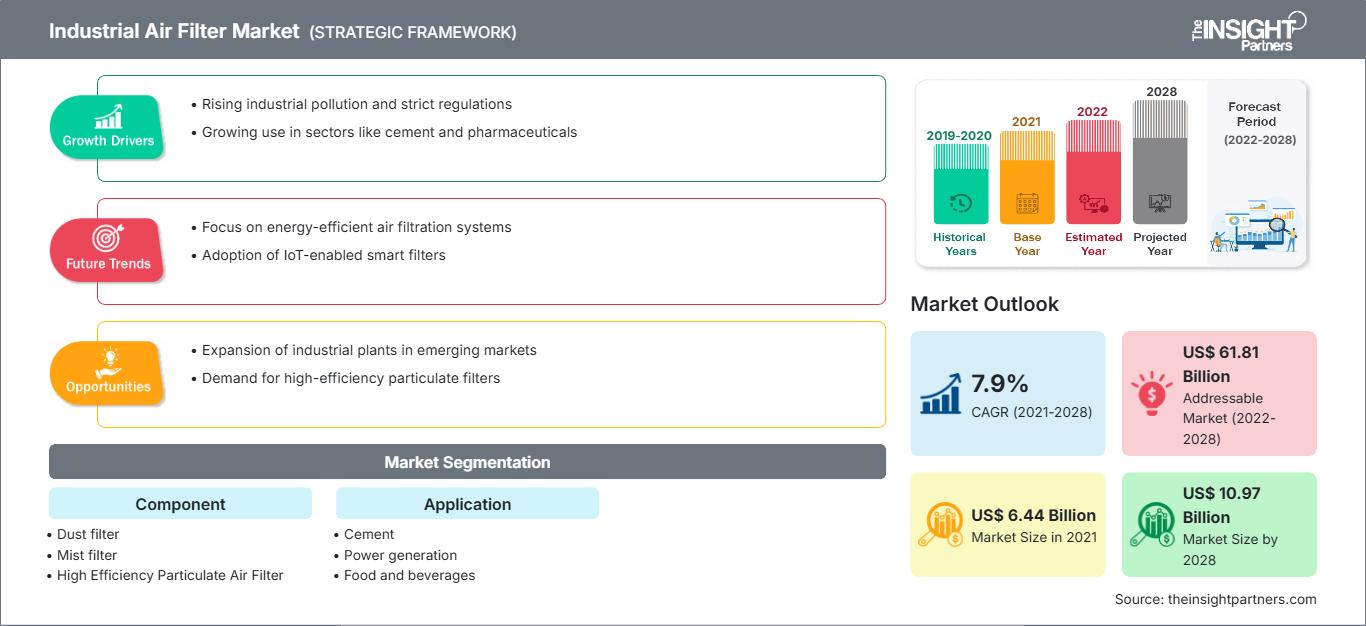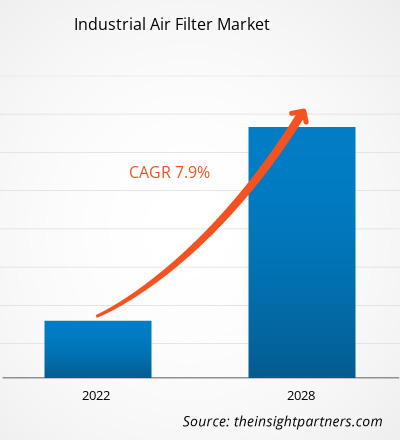産業用エアフィルター市場規模は2024年に131.4億米ドルに達すると推定され、2031年までに201億米ドルに達すると予想されています。産業用エアフィルター市場は、2025年から2031年の間に6.7%のCAGRを記録すると予測されています。
産業用エアフィルター市場分析
重工業、電力、セメント、金属、化学といった産業界が、排出規制の厳格化、都市化の進展、そして職場の安全と空気質基準の厳格化に直面しているため、産業用エアフィルターの需要は高まっています。高効率媒体、エネルギー効率の高いシステム設計、そしてIoTを活用した予知保全型ろ過ソリューションを提供するサプライヤーは、この導入によって大きなメリットを享受できるでしょう。
産業用エアフィルター市場の概要
産業用空気ろ過の主な目的の一つは、機械を保護し、清浄な空気を供給し、環境規制を遵守し、産業プロセスから有害な粒子を除去することで安全性を維持することです。空気ろ過器は、空調、製薬、食品・飲料加工、発電、電子機器製造、鉱業、化学プラント、石油・ガス、自動車産業など、さまざまな業界やシステムで使用されています。
要件に合わせてレポートをカスタマイズ
このレポートの一部、国レベルの分析、Excelデータパックなど、あらゆるレポートを無料でカスタマイズできます。また、スタートアップや大学向けのお得なオファーや割引もご利用いただけます。
産業用エアフィルター市場:戦略的洞察

-
このレポートの主要な市場動向を入手してください。この無料サンプルには、市場動向から見積もりや予測に至るまでのデータ分析が含まれます。
産業用エアフィルター市場の推進要因と機会
市場の推進要因:
- 厳格な規制要件:空気質規制の強化と持続可能性目標の達成により、産業用エアフィルターの需要が大幅に増加しています。鉄鋼、セメント、電力、化学、製薬、食品・飲料など、様々な業界では、米国大気浄化法、EUのIED/REACH、中国、インドのNCAP/MoEFCCの排出ガス基準および職場の空気質基準を遵守するために、HEPA、ULPA、静電式、活性炭式など、様々なタイプのフィルターが使用されています。
- 世界的な産業拡大:パンデミック後の産業復興と、自動車、セメント、化学、金属、電子機器セクターにおける製造業の生産量増加は、排出負荷と職場における曝露リスクを増大させています。工場の規模拡大と近代化が進むにつれ、各工場は、規制遵守、作業間の労働時間削減、そしてアジア太平洋、ラテンアメリカ、中東における産業化プロセスを支えるために、効率的な粉塵、煙、ガスろ過システムの導入を積極的に進めています。
- 健康、安全、環境への意識:産業界における高度な空気ろ過技術の急速な導入を促している要因の一つは、機器の損傷や生産性の低下に加え、粉塵、煙、VOCによる健康リスクへの意識の高まりです。企業はOSHA/WHOのガイダンスに準拠し、HEPAフィルターや活性炭フィルターを標準装備として導入し、クリーンエアの提供を単なるコンプライアンスコストではなく、ESG(環境・社会・ガバナンス)および従業員の福利厚生への戦略的な投資と捉えています。
市場機会:
- スマートでIoT対応の空気ろ過システム:インテリジェントな空気清浄装置は、センサー、通信、分析技術を駆使し、粒子状物質の量、圧力損失、湿度、空気の流れを継続的に測定します。それに応じて、予知保全アラートとファン制御が開始されます。さらに、フィルター寿命の延長、エネルギー消費量の削減、安全性の向上、そしてますます厳しくなる環境規制や運用パフォーマンス規制への施設の準拠を実現します。
- 世界の水力発電開発:インド、中国、ヨーロッパ、東南アジア、北米における水力発電の急速な拡大に伴い、タービンの汚染や制御システムの誤動作を防ぎ、作業員の安全を確保するための高度な空気フィルターの必要性が高まっています。高効率でIoTに対応したソリューションは、タービンホールや制御室の清浄度を維持し、故障の発生を低減し、設備寿命を延ばし、規制に適合した安定した再生可能エネルギー発電を促進します。
- エネルギー効率と持続可能性に優れたソリューション:産業界のユーザーは、ファンのエネルギー消費量とライフサイクルコストを削減できる、低圧力損失、セルフクリーニング機能、モジュール式機能を備えたフィルターを徐々に選択しています。同様に、リサイクル可能な素材や環境負荷の少ない素材の採用も、ESG目標の達成に貢献します。これらの製品は、インテリジェントな監視機能や予測メンテナンスと組み合わせることで、交換間隔やエアフローの最適化を支援し、空気質、エネルギー節約、持続可能性の優先事項を調和させることができます。
産業用エアフィルター市場レポート:セグメンテーション分析
産業用エアフィルター市場は、その仕組み、成長の可能性、そして最新のトレンドをより明確に把握するために、様々なセグメントに分割されています。以下は、業界レポートで用いられる標準的なセグメンテーション手法です。
メディア別:
- グラスファイバー: 長い塵埃保持能力、耐熱性、さらには産業汚染物質にも耐える能力を備えたグラスファイバー製エアフィルターは、HVAC システム、クリーンルーム、重工業施設の第一選択肢となっています。
- 金属: 金属製のエアフィルターは、その強固な構造、高温耐性、耐腐食性により人気があり、製造工場、発電施設、化学処理、厳しい条件の HVAC システムなどの厳しい産業環境に最適です。
- 不織布
- 活性炭
- その他
製品別:
- バッグフィルター:バッグフィルターは、業界で最も人気のあるエアフィルターで、産業用空気ろ過において、塵埃、粒子状物質、その他の空気中の汚染物質を捕捉するために使用されています。バッグフィルターは布製のフィルターバッグで作られており、空気は通過しますが、粒子はバッグの表面に付着します。これらのフィルターは、金属加工、セメント、発電、鉱業など、塵埃が発生する業界では標準的なフィルターです。
- カートリッジフィルター
- HEPAフィルター
- 電気集塵機
- その他
業種別:
- 食品と飲料
- 発電
- 半導体およびエレクトロニクス
- 化学および石油化学製品
- 健康管理
- 金属および鉱業
- 紙と絵の具
- その他
地理別:
- 北米
- ヨーロッパ
- アジア太平洋
- 南アメリカ
- 中東・アフリカ
産業用エアフィルター市場の地域別分析
予測期間全体を通して産業用エアフィルター市場に影響を与える地域的なトレンドと要因は、The Insight Partnersのアナリストによって徹底的に解説されています。このセクションでは、北米、ヨーロッパ、アジア太平洋、中東・アフリカ、中南米における産業用エアフィルター市場のセグメントと地域についても解説します。
産業用エアフィルター市場レポートのスコープ
| レポート属性 | 詳細 |
|---|---|
| 2024年の市場規模 | 131億4000万米ドル |
| 2031年までの市場規模 | 205億1000万米ドル |
| 世界のCAGR(2025年~2031年) | 6.7% |
| 履歴データ | 2021-2023 |
| 予測期間 | 2025~2031年 |
| 対象セグメント |
メディア別
|
| 対象地域と国 |
北米
|
| 市場リーダーと主要企業の概要 |
|
産業用エアフィルター市場のプレーヤー密度:ビジネスダイナミクスへの影響を理解する
産業用エアフィルター市場は、消費者の嗜好の変化、技術の進歩、製品メリットへの認知度の高まりといった要因によるエンドユーザー需要の増加に牽引され、急速に成長しています。需要の増加に伴い、企業は製品ラインナップの拡充、消費者ニーズへの対応のためのイノベーション、そして新たなトレンドの活用を進めており、これが市場の成長をさらに加速させています。

- 産業用エアフィルター市場のトップキープレーヤーの概要を入手
産業用エアフィルターの地域別市場シェア分析
北米、ヨーロッパ、アジア太平洋地域(APAC)、中東・アフリカ地域(MEA)、南米は、世界の産業用空気フィルター市場を分析するための調査対象地域です。2024年には北米が最大の市場シェアを占め、次いでアジア太平洋地域とヨーロッパが続きました。急速な工業化、都市化、そしてクリーンエネルギー、製造業、インフラへの投資により、APAC地域は予測期間中に最も高いCAGRを達成すると予測されています。
以下は地域別の市場シェアと傾向の概要です。
1. 北米
- 市場シェア: 特に米国が最大の市場であり、自動車、ヘルスケア、製造業の好調によりカナダがそれに続きます。
-
主な推進要因:
- 大気質指数への高い意識
- 著名なOEMの存在
- トレンド: エネルギー効率の高いソリューションの急速な導入。
2. ヨーロッパ
- 市場シェア: 厳格な規制の結果、EMEA 地域内で最大のシェアを保持しています。
-
主な推進要因:
- 化学、電力、プロセス産業のアップグレード
- 政府による脱炭素化プログラム
- トレンド: 高効率 HEPA/活性炭メディアの改造。
3. アジア太平洋
- 市場シェア: 地域における急速な工業化とフィルター製造の成長により、最も急速に成長している市場です。
-
主な推進要因:
- 鉱業とセメント産業の拡大
- スマートシティ開発への投資
- トレンド: 基本メディアから高性能メディアへの移行。
4. 中東およびアフリカ
- 市場シェア: 石油・ガス産業が牽引する新興市場。
-
主な推進要因:
- インフラ(建設、エネルギー、公共事業)の大規模な拡張
- 大気質プログラムへの政府投資の増加
- トレンド:世界のメーカーを誘致するための取り組みとインセンティブ
5. 南アメリカ
- 市場シェア: ブラジルとチリの鉱業部門の成長に大きく支えられ、市場は成長しています。
-
主な推進要因:
- 自動車産業とヘルスケア産業の拡大
- インフラ開発プログラム
- トレンド: 世界中のサプライヤーと協力して水ろ過プラントをアップグレードします。
産業用エアフィルター市場のプレーヤー密度:ビジネスダイナミクスへの影響を理解する
中規模市場の密度と競争
Donaldson、HYDAC International GmbH、Eaton Corp Plc、Parker Hannifin Corp、Alfa Laval AB、Filtcare Technology Pvt. Ltd.などの既存企業の存在により、競争は熾烈です。また、地域企業やニッチ企業も、さまざまな地域で競争環境を激化させています。
この高いレベルの競争により、企業は次のようなものを提供して差別化を図ろうとしています。
- 優れたパフォーマンス: 重要な空気処理アプリケーションにおける交換回数とライフサイクル全体のコストを削減する、高効率で長寿命の産業用エアフィルター。
- 低圧力降下構成によりファンの電力消費を抑え、ユーザーが省エネと ESG 目標を達成できるようにします。
- 空気の質と圧力降下を継続的に測定するセンサー付きユニットにより、予測に基づいたメンテナンスが可能になり、計画外のダウンタイムが短縮されます。
- 小型のモジュール式フィルターエレメントとハウジングは、簡単に改造でき、ボトルネックを解消し、将来の容量増加に合わせて拡張できます。
機会と戦略的動き
- 工場、商業ビル、輸送インフラ全体にわたるクリーンエアソリューションのスムーズな統合、データ接続、迅速な導入を保証するために、大手産業用空気フィルターサプライヤーは、HVAC OEM、オートメーションベンダー、IoT プラットフォームプロバイダーとの関係を強化しています。
- 主要サプライヤーは、様々な用途における気流、汚染物質、そしてスペースの制約に合わせて容易に拡張、アップグレード、構成できる、拡張性の高いモジュール式産業用空気濾過システムを発売しています。これらのシステムには、ハウジング、フィルターモジュール、ファン、そして制御装置が含まれます。
免責事項:上記の企業は、特定の順序でランク付けされているわけではありません。
調査の過程で分析した他の企業:
- カムフィルAB
- AAFインターナショナル
- ハネウェル・インターナショナル社
- リダル株式会社
- フロイデンベルグ濾過技術
産業用エアフィルター市場のニュースと最近の動向
-
HYDAC International GmbHが新製品を発表しました。HYDAC
International GmbHは、プロセスの要求を満たすように設計された自動バックフラッシュフィルターとエンジニアリングろ過システムを展示したと発表しました。 - Hollingsworth & Voseは、よりクリーンで健康的、そしてより持続可能なエコシステムの実現を目指し、PFAS不使用の高性能ソリューション製品ライン「PlusZero」を発売しました。さらに、H&VのPlusZero製品ラインは、製造工程における化学物質の使用を永久に排除することで、持続可能性の目標達成を支援する先進技術を活用します。
産業用エアフィルター市場レポートの対象範囲と成果物
「産業用エアフィルター市場の規模と予測(2021~2031年)」レポートでは、以下の分野を網羅した市場の詳細な分析を提供しています。
- 産業用エアフィルターの市場規模と予測、およびスコープに含まれるすべての主要市場セグメントの世界、地域、国レベルでの予測
- 産業用エアフィルター市場の動向、および推進要因、制約、主要な機会などの市場動向
- 詳細なPEST分析とSWOT分析
- 主要な市場動向、世界および地域の枠組み、主要プレーヤー、規制、最近の市場動向を網羅した工業用液体フィルター市場分析
- 産業用エアフィルター市場における市場集中、ヒートマップ分析、主要プレーヤー、最近の動向を網羅した業界の展望と競争分析
- 詳細な企業プロフィール
- 過去2年間の分析、基準年、CAGRによる予測(7年間)
- PEST分析とSWOT分析
- 市場規模価値/数量 - 世界、地域、国
- 業界と競争環境
- Excel データセット
最新レポート
関連レポート
お客様の声
購入理由
- 情報に基づいた意思決定
- 市場動向の理解
- 競合分析
- 顧客インサイト
- 市場予測
- リスク軽減
- 戦略計画
- 投資の正当性
- 新興市場の特定
- マーケティング戦略の強化
- 業務効率の向上
- 規制動向への対応






















 無料サンプルを入手 - 産業用エアフィルター市場
無料サンプルを入手 - 産業用エアフィルター市場